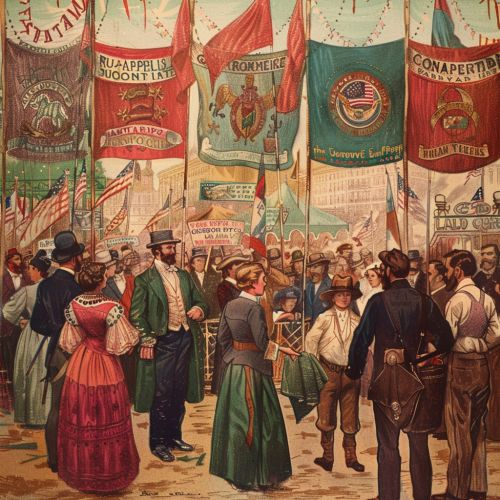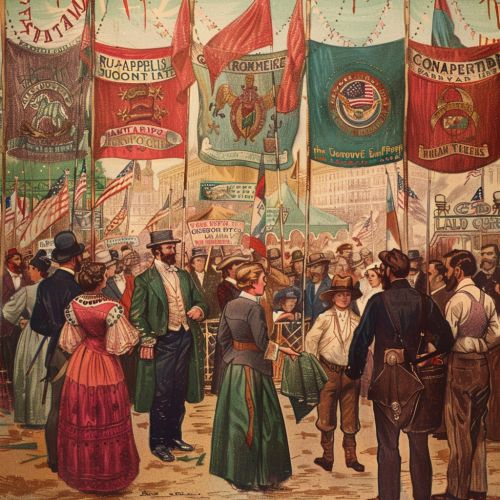History of the Republican Party (United States)
Origins and Formation (1854-1860)
The Republican Party was founded in the mid-19th century as a response to the Kansas-Nebraska Act of 1854, which allowed for the potential expansion of slavery into the western territories. The party emerged from a coalition of anti-slavery Whigs, Free Soilers, and anti-slavery Democrats. The first official meeting took place in Ripon, Wisconsin, and the party was formally organized in Jackson, Michigan, later that year.
The early platform of the Republican Party was centered around opposition to the expansion of slavery, advocating for a free labor economy and the promotion of infrastructure development. The party quickly gained traction in the northern states, attracting a diverse group of supporters, including industrialists, farmers, and abolitionists.
Civil War and Reconstruction (1861-1877)
The election of Abraham Lincoln in 1860, the first Republican president, marked a significant turning point in American history. Lincoln's victory prompted the secession of southern states and the onset of the American Civil War. The Republican Party, under Lincoln's leadership, was committed to preserving the Union and eventually to the abolition of slavery, culminating in the Emancipation Proclamation of 1863 and the passage of the Thirteenth Amendment in 1865.
During the Reconstruction era, the Republican Party played a crucial role in the reintegration of the southern states and the protection of the newly freed African Americans' rights. The party supported the Fourteenth and Fifteenth Amendments, which granted citizenship and voting rights to African Americans, respectively. However, the end of Reconstruction in 1877 marked the beginning of a long period of Republican decline in the South.
Gilded Age and Progressive Era (1878-1920)
The late 19th and early 20th centuries saw the Republican Party align itself with the interests of big business and industrialization. The party's economic policies favored high tariffs, the gold standard, and limited government intervention in the economy. This period, known as the Gilded Age, was characterized by rapid economic growth and significant social and political changes.
Prominent Republican leaders during this time included William McKinley, who presided over the Spanish-American War and the annexation of territories such as Puerto Rico and the Philippines, and Theodore Roosevelt, who championed progressive reforms. Roosevelt's presidency marked a shift towards progressivism within the party, advocating for antitrust laws, conservation efforts, and social justice initiatives.


Interwar Period and the Great Depression (1921-1945)
The Republican Party dominated the political landscape during the 1920s, with presidents Warren G. Harding, Calvin Coolidge, and Herbert Hoover promoting policies of economic laissez-faire and isolationism. However, the onset of the Great Depression in 1929 severely undermined public confidence in the party's economic policies.
Herbert Hoover's response to the economic crisis was widely criticized as inadequate, leading to the election of Democrat Franklin D. Roosevelt in 1932. Roosevelt's New Deal programs aimed to provide relief, recovery, and reform, significantly expanding the role of the federal government in the economy. The Republican Party, now in opposition, struggled to redefine its platform in the face of widespread support for New Deal policies.
Post-World War II and the Cold War (1946-1980)
In the aftermath of World War II, the Republican Party sought to regain its influence by focusing on anti-communism and advocating for a strong national defense. The election of Dwight D. Eisenhower in 1952 marked a period of moderate Republicanism, with policies that balanced fiscal conservatism with social welfare programs.
The Cold War era saw the Republican Party emphasize a strong stance against the Soviet Union and communism. The party's platform included support for military alliances such as NATO and policies aimed at containing the spread of communism. The 1960s and 1970s were marked by internal divisions within the party, particularly over issues such as civil rights and the Vietnam War.
Reagan Era and Conservative Resurgence (1981-2000)
The election of Ronald Reagan in 1980 heralded a new era of conservative dominance within the Republican Party. Reagan's presidency was characterized by a focus on supply-side economics, tax cuts, deregulation, and a strong anti-communist foreign policy. Reagan's charismatic leadership and optimistic vision helped to solidify the Republican Party's appeal to a broad coalition of voters, including religious conservatives, business interests, and blue-collar workers.
The 1990s saw the continuation of conservative policies under President George H. W. Bush, who oversaw the end of the Cold War and the Gulf War. The Republican Party also achieved significant legislative victories with the Contract with America in 1994, led by Speaker of the House Newt Gingrich, which aimed to implement a series of conservative reforms.
21st Century and Modern Developments (2001-Present)
The early 21st century has been a period of significant change and challenges for the Republican Party. The presidency of George W. Bush was marked by the September 11 attacks, the subsequent War on Terror, and the Iraq War. Domestically, Bush's administration focused on tax cuts, education reform, and efforts to privatize Social Security.
The election of Barack Obama in 2008 led to a period of introspection and re-evaluation within the Republican Party. The rise of the Tea Party movement in 2009 reflected a growing dissatisfaction with the party's establishment and a push for more conservative and libertarian policies.
The election of Donald Trump in 2016 represented a significant shift in the party's direction, with a focus on populism, nationalism, and anti-globalization. Trump's presidency was marked by controversial policies on immigration, trade, and foreign relations, as well as significant tax reforms and deregulation efforts.
See Also
- Whig Party (United States)
- Free Soil Party
- American Civil War
- Emancipation Proclamation
- New Deal
- Cold War
- Tea Party movement
